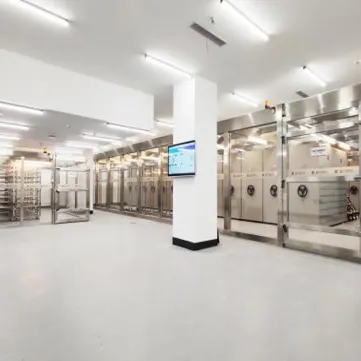It is important to preserve artifacts from historical events so that we can remember, understand and respect those who participated in them. When an artifact is preserved to maintain its current state, it preserves the authenticity of the historical story for future generations.
Sometimes the terms restoration and preservation are used interchangeably, which is incorrect. There is a significant difference between preservation and restoration, each having its own purpose and appropriate time for application.
Restoration involves a timely review to determine how the object looked during its original time period. Processing measures are completed to restore the object to the way it was originally created. Depending on the artefact, this may involve various processes such as removing layers of paint, adding material to the object or replacing parts from a particular era.
Airtight And Constant Humidity (low Oxygen) Warehouse
Preservation involves looking forward and taking steps to keep the object in its current state. This may include treatments that reduce damage and protect its current state, even though a small amount of damage may be caused to the object.
A range of conservation techniques are used to extend the life of historical and cultural artefacts, or at least slow down the rate of deterioration.
For example, non-invasive techniques such as X-ray photography and infrared photography can be used for the analysis of artworks to carry out detailed investigations into the chemical composition of paintings. Knowing the paint used may mean that scientists can assess the deterioration path of pigments and materials over time.
It is always encouraged to avoid handling workpieces. This is because human skin contains oils, acids and salts that can damage most types of material over time. It is recommended that clean cotton or latex gloves are worn when objects need to be touched, for example when repositioning artefacts or storing them in storage. If objects may slip off when wearing gloves, use clean, dry, emulsion-free hands.
Airtight And Constant Humidity (low Oxygen) Warehouse
Speaking of carpets, antique rugs and carpets are often made of wool or silk. This makes them vulnerable to insect attack. Vacuuming both sides of the carpet with an upholstery attachment will eliminate insect infestation, provided it is done once a week and continues for at least six weeks after the last sign of infestation. To avoid damage to the carpet by vacuuming, the nozzles should be covered with stockings.
Fading is a major problem that museums and historic buildings must address in order to preserve their heritage. Solar energy accounts for about 90% of the fading and three different bands contribute to it.
Ultraviolet (UV) radiation is invisible to the human eye, but it is the most damaging type of light to museum collections and historical artefacts. Visible light is visible to the human eye and is divided into different colours of the rainbow. Infrared radiation is also invisible to the human eye, but can be felt as heat.
Low-oxygen(Constant Humidity) And Clean Showcase
It is these different wavelengths that cause the degradation of important and often priceless artefacts.
Very sensitive (50 lux) objects that therefore require more protection include clothing and textiles, prints, manuscripts, drawings, watercolours, old colour photographs and miniature models. Moderately sensitive objects (200 lux) include paintings, wood, furniture, bones, cow horns, ivory, undyed leather and modern black and white photographs. Insensitive objects (300 lux) include stone, ceramics, metal and glass.
Atmospheric-Pressure Low Oxygen Controlled Atmosphere Insecticidal Warehouse/ Cabinet
High airtight enclosure structure and ultra-low oxygen environment are used for cultural relics to kill insects and inhibit bacteria.
It is used for scripts and paintings, books, archives, silk, leather products, animal and plant specimens, dried corpses, lacquerware, engravings and other organic collections to kill insects and inhibit bacteria.
Nitrogen-filled And Freezing Insecticidal System
It is used for mildew and insect prevention, constant humidity cleaning, elimination of acidification, oxidation and chemical corrosion and low oxygen fire prevention of cultural relics and collections of organic materials and metal materials, providing long-term preventive protection and storage of the collections. The displaying and storing function can be realized at the same time when the glass enclosure structure is used. It also can be used as fireproof warehouse when the oxygen content is lower than the combustion conditions.
Designed for the Capital Museum, Shanghai Library, Chongqing Red Rock Revolutionary History Museum, the high airtight and constant humidity (low oxygen) and clean warehouses realize the“stable, cleanness, constant humidity, low-oxygen”storage and display. The follow-up test indicates that after 26-day low oxygen static storage, the variation of the oxygen content and relative humidity is 2.4% and 3.8% respectively.
To find out more about our low oxygen controlled atmosphere insecticidal warehouse, please contact us.
 Museum Collection Storage Warehouse
Museum Collection Storage Warehouse
 Low Oxygen Constant Humidity and Clean Warehouse
Low Oxygen Constant Humidity and Clean Warehouse
 Museum Drawer Cabinets
Museum Drawer Cabinets
 Low-oxygen(constant Humidity) And Clean Storage Cabinet
Low-oxygen(constant Humidity) And Clean Storage Cabinet
 Atmospheric-Pressure Low Oxygen Controlled Atmosphere Insecticidal Warehouse/ Cabinet
Atmospheric-Pressure Low Oxygen Controlled Atmosphere Insecticidal Warehouse/ Cabinet
 Museum Wall Display Case
Museum Wall Display Case
 Museum Table Display Cases
Museum Table Display Cases
 Museum Exhibit Display Cases
Museum Exhibit Display Cases